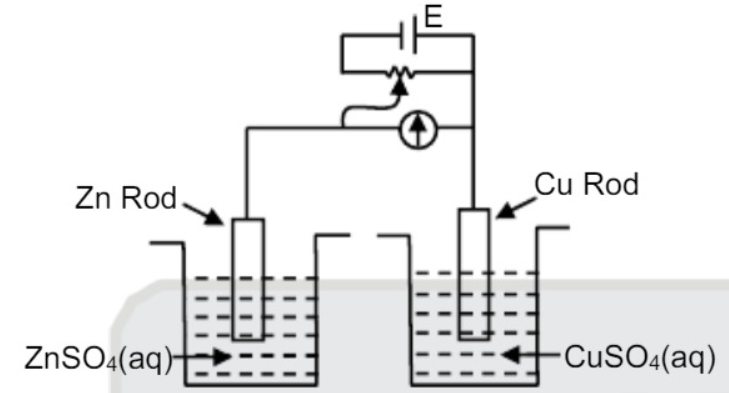A galvanic cell consists of a metallic zinc plate immersed in 0.1 M Zn(NO3)2 solution and metallic plate of lead in 0.02M Pb(NO3)2 solution. Calculate the emf of the cell.
Write the chemical equation for the electrode reactions and represent the cell.
(Given:E∘Zn2+ZN=−0.76V, <br>E∘Pb2+/Pb=−0.13V)
To solve the problem of calculating the EMF of the galvanic cell consisting of a zinc plate in a zinc nitrate solution and a lead plate in a lead nitrate solution, we will follow these steps:
Step 1: Identify the Anode and Cathode
- In a galvanic cell, the anode is where oxidation occurs, and the cathode is where reduction occurs.
- Here, zinc (Zn) will act as the anode because it has a more negative standard reduction potential compared to lead (Pb).
Step 2: Write the Half-Reactions
- Anode Reaction (Oxidation):
Zn→Zn2++2e−
- Cathode Reaction (Reduction):
Pb2++2e−→Pb
Step 3: Write the Overall Cell Reaction
- Combining the half-reactions, we get:
Zn+Pb2+→Zn2++Pb
Step 4: Write the Cell Representation
- The cell can be represented as:
Zn (s)|Zn2+(aq)||Pb2+(aq)|Pb (s)
Step 5: Calculate the Standard EMF (E°cell)
- Given:
- E∘Zn2+/Zn=−0.76V
- E∘Pb2+/Pb=−0.13V
- The standard EMF of the cell is calculated using:
E∘cell=E∘cathode−E∘anode=(−0.13)−(−0.76)=0.63V
Step 6: Use the Nernst Equation to Calculate the EMF
- The Nernst equation is:
E=E∘cell−0.0592nlog((Zn2+)(Pb2+))
- Here, n=2 (number of electrons transferred).
- Concentrations:
- (Zn2+)=0.1M
- (Pb2+)=0.02M
Step 7: Substitute Values into the Nernst Equation
- Substitute the values into the equation:
E=0.63−0.05922log(0.10.02)
E=0.63−0.0296log(5)
- Calculate log(5)≈0.699:
E=0.63−0.0296×0.699
E=0.63−0.0207≈0.6093V
Final Answer
The EMF of the cell is approximately 0.6093 V.
---
- In a galvanic cell, the anode is where oxidation occurs, and the cathode is where reduction occurs.
- Here, zinc (Zn) will act as the anode because it has a more negative standard reduction potential compared to lead (Pb).
- Anode Reaction (Oxidation):
Zn→Zn2++2e−
- Cathode Reaction (Reduction):
Pb2++2e−→Pb
- Combining the half-reactions, we get:
Zn+Pb2+→Zn2++Pb
- The cell can be represented as:
Zn (s)|Zn2+(aq)||Pb2+(aq)|Pb (s)
- Given:
- E∘Zn2+/Zn=−0.76V
- E∘Pb2+/Pb=−0.13V
- The standard EMF of the cell is calculated using:
E∘cell=E∘cathode−E∘anode=(−0.13)−(−0.76)=0.63V
- The Nernst equation is:
E=E∘cell−0.0592nlog((Zn2+)(Pb2+))
- Here, n=2 (number of electrons transferred).
- Concentrations:
- (Zn2+)=0.1M
- (Pb2+)=0.02M
- Substitute the values into the equation:
E=0.63−0.05922log(0.10.02)
E=0.63−0.0296log(5)
- Calculate log(5)≈0.699:
E=0.63−0.0296×0.699
E=0.63−0.0207≈0.6093V
The EMF of the cell is approximately 0.6093 V.
Similar Questions
Calculate the maximum work that can be obtained from the decimolar Daniell cell at 25∘C.
Given Ec−.(Zn2+∣Zn)=−0.76V and Ec−.(Cu2+∣Cu)=0.34VView SolutionConstruct a cell using given electrodes at 298K and also calculate its standart EMF.
Given : Ec−.Zn∣Zn2+=0.76V
Ec−.Cu2+∣Cu=0.34VView SolutionA volataic cell consists of an electode of solide silver immerse in a 0.10MAgNO3 solution and an electrode of unknown metal 'X' immersed in a 0.10M solution X(NO3)2. A porous barrier separates the two half of the cell. Also given :
Ec−.(Ag⊕∣Ag)=0.80V and Ec−.cell=1.05V at 25∘C
X(s)∣∣X2+(1.0M)∣∣∣∣Ag⊕(0.1M)∣∣Ag(s)
If Ag⊕∣Ag half cell in the above voltaic cell is replaced by Zn2+∣Zn half cell (Ec−.Zn2+∣Zn=−0.76V)View SolutionCalculate the e.m.f. of a cell in which the following reactions take place at different electrodes.
Zn2++2e−→Zn,EΘ=−0.76V ...(i)
Ag++e−→Ag,EΘ=0.79V ...(ii)View SolutionFor the given cell arrangement identify incorrect statement
given E∘_(Cu2+/Cu) = 0.34V &E∘_(Zn2+/Zn)=−0.76V View Solution
View SolutionCalculate Ecell at 25∘C for the reaction :
Zn+Cu2+(0.20M)→Zn2+(0.50M)+Cu
Given EΘ(Zn2+/Zn)=−0.76V,EΘ(Cu2+/Cu)=0.34V.View SolutionCan a solution of 1 M ZnSO4 be stored in a vessel made of copper ? Given that
E∘Zn+2/Zn=−0.76VandE∘Cu+2/Cu=0.34VView SolutionWhat is the effect of increase in concentration of zinc ions on the electrode potential of zinc electrode for which EZn2+/Zn equals - 0.76 V
View SolutionFind the E∘cell for the following cell reaction
Fe+2+Zn→Zn+2+Fe
Given E∘Zn/Zn+2=0.76V,E∘Fe/Fe+2=+0.41VView SolutionA disposable galvanic cell Zn∣∣Zn2+∣∣∣∣Sn2+∣∣SN is produced using 1.0mL of 0.5MZn(NO3)2 and 1.0mL of 0.50MSn(NO3)2. It is needed to power a pace maker that draws a constant current of 10−6 Amp to run it and requires atleast 0.50V to function. Calculate the value of ∣∣Zn+2∣∣ when cell reaches 0.5V at 298K.
(Given: E∘(Zn2+/Zn)=−0.76V:E∘(SN2+/Sn)=−0.14V).View Solution

